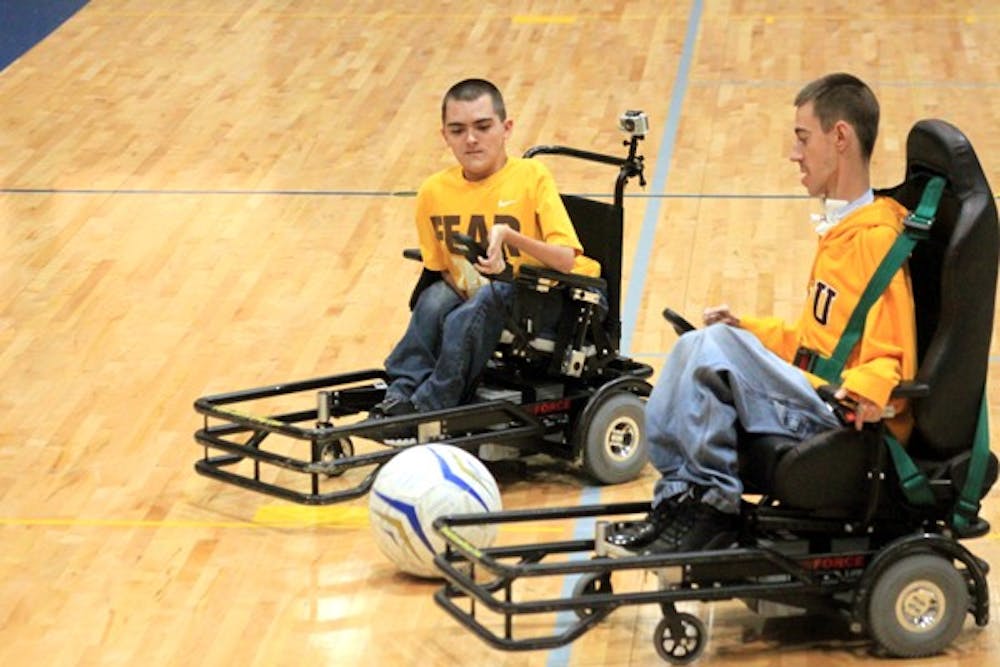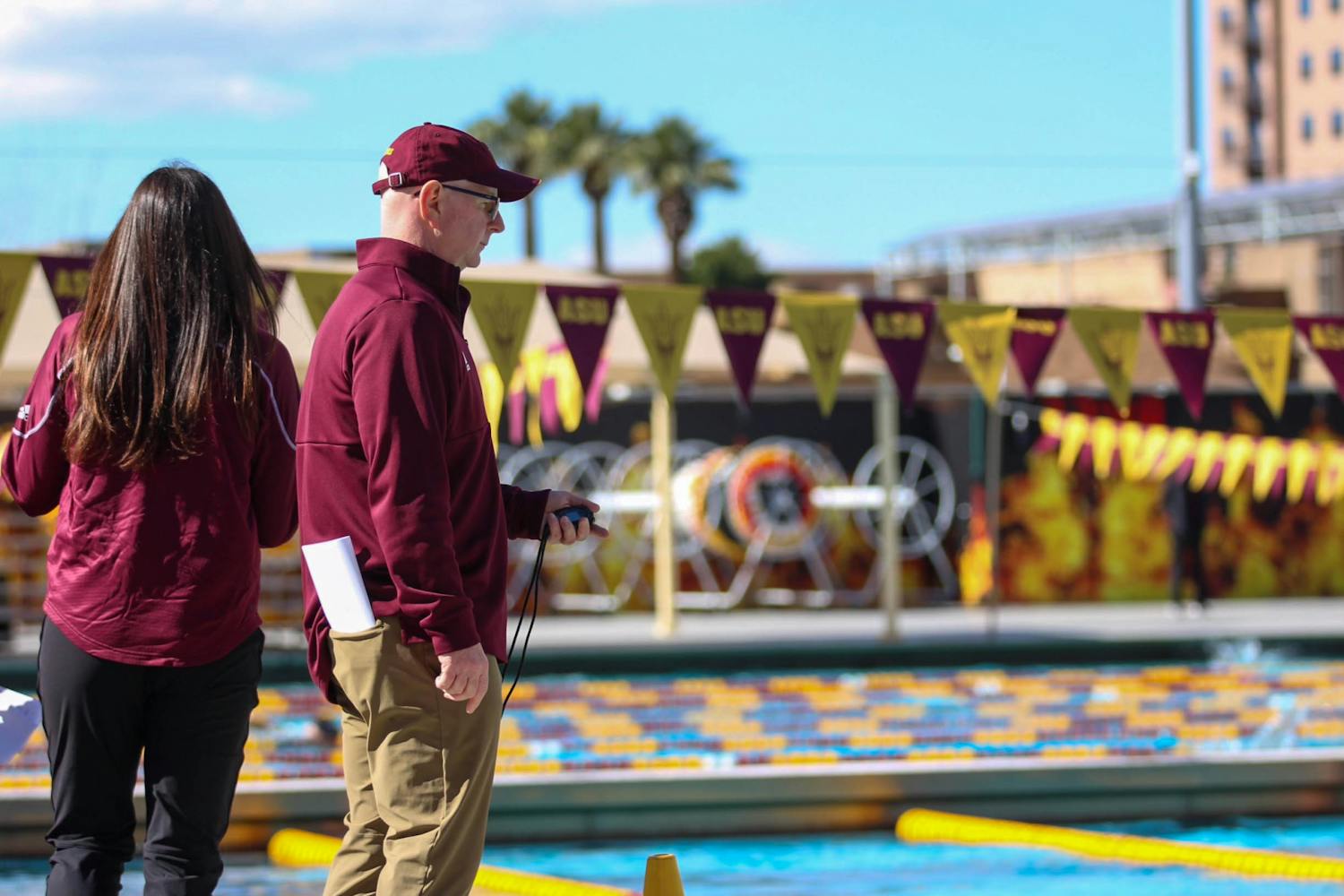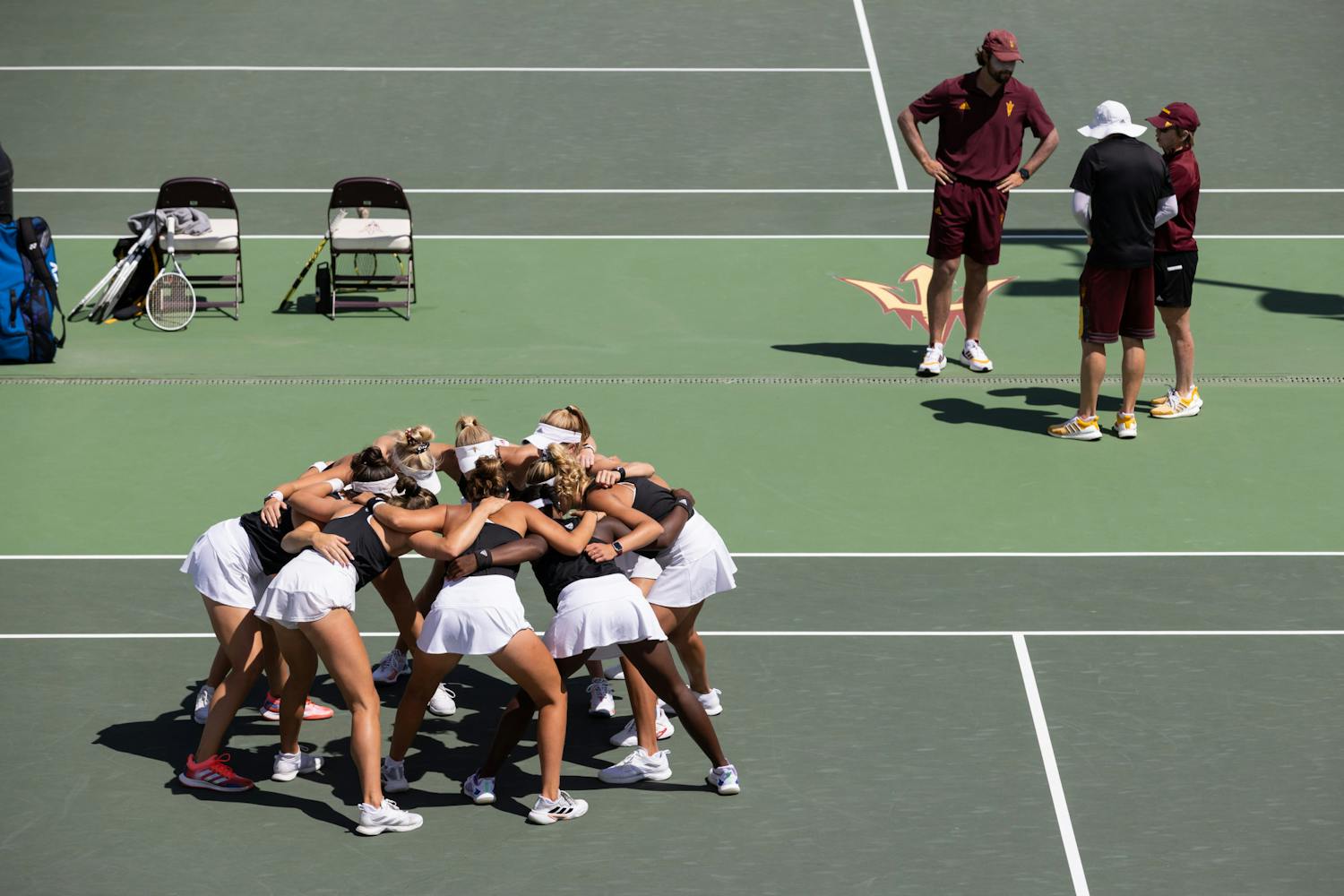Video Produced by Nick Prete
As ASU's Power Soccer Team rolls onto the court, it's hard not to notice the players' confidence, preparation and focus. It is a team of ordinary athletes with an extraordinary pastime: power soccer, an adaptive sport for people with disabilities.
Power soccer provides people in electric wheelchairs a unique opportunity to play a modified form of soccer while creating confidence and friendships and giving them a chance to compete.
American media and pop culture graduate student Gabe Trujillo said power soccer gave him a second chance at shining on an athletic court.
"When I became confined to a wheelchair, I thought my time as an athlete was over," Trujillo said. "But when I stumbled across power soccer, I realized that there was more time for me to be an athlete."
The ASU Power Soccer Team has been competing for three seasons, since Trujillo and several teammates formed a four-person team in 2010.
"When I first started power soccer, I immediately knew that everyone that was confined to a wheelchair needed to get this opportunity," Trujillo said.
Playing the game
Power soccer is a sport specifically for people in power chairs and is the only sport that allows people with a weakness in all four limbs to participate.
Four team members, including a goalie, can be on the basketball court where the game is played.
Players have a metal or plastic guard on the bottom of their wheelchairs, around their feet, that allows them to pass the ball between players or into the goal. The guards vary in height, size and material, depending on the player's skill level and preference.
Global studies and justice studies senior Katie Dickey said power soccer is more of a team sport than regular soccer.
"It is turned into much more of a passing game," Dickey said. "You turn the chair to hit the ball."
The game is divided into two 20-minute periods and only has minimal adaptations to make the game easy to play in a smaller area with fewer people.
The team's assistant coach, Barbra Peacock, said power soccer allows players to develop teamwork, confidence and friendships.
"Most people don't realize it, but P.E. teaches kids teamwork, and these kids don't get that," Peacock said. "That's why this sport makes such a huge difference."
In addition to learning teamwork, Peacock said power soccer provides camaraderie for the players that they usually do not get in their everyday lives.
"Usually they are the only ones in their school with a physical disability, but they can get together and be all like, 'I am not the weirdo. We can get together and help each other out,'" Peacock said.
 Jordan Dickey (left) and Joey Wells (right) compete for possession of the ball at a practice for the ASU Power Soccer team. Players use the guards on the front of their power chairs to maneuver a large soccer ball around a basketball court. (Photo by Ashley Kesweder)
Jordan Dickey (left) and Joey Wells (right) compete for possession of the ball at a practice for the ASU Power Soccer team. Players use the guards on the front of their power chairs to maneuver a large soccer ball around a basketball court. (Photo by Ashley Kesweder)
A Rare Case
Trujillo was a freshman in high school when he became a quadriplegic.
Trujillo, an asthmatic, got a case of pneumonia that continued to get worse, despite the treatment he was receiving. He was transferred from Desert Samaritan Hospital to Phoenix Children's Hospital, where he fell into a coma. Four days later, Trujillo woke up and found out that he had lost the ability to move his arms and legs.
Trujillo had Hopkins Syndrome, an ultra-rare form of polio that is more prevalent in asthmatics. Hopkins Syndrome has less than 30 documented cases in the world, Trujillo said.
"Usually (Hopkins Syndrome) only affects one limb," Trujillo said. "As far as we can tell, I am the only documented case with all four limbs being affected in the entire world."
It took eight months of therapy for Trujillo to regain as much of his strength as possible and be released.
While in the hospital, Trujillo worked hard to complete his freshman year of high school by working with an in-hospital teacher.
"Before I became confined to a wheelchair, I was always an avid student," Trujillo said. "When I found out that I would be missing out on my entire freshman year, I wanted to make sure I was still able to keep up with my school work."
A therapist approached Trujillo and urged him to write down his experiences, a suggestion that would redirect Trujillo's life.
"Once I was released, I realized that I had a new career path," Trujillo said. "It was then I decided that I wanted to go into writing."
Trujillo completed high school with the rest of his class and then began work on a bachelor's degree in journalism at ASU.
While working as a reporter for The State Press in 2005, Trujillo was directed to the Student Recreation Center's adaptive sports program, where he hoped to cover the wheelchair rugby team. Because the rugby team was not currently playing, Trujillo was redirected to the power soccer team that practiced in Mesa.
"They were holding tryouts in Mesa, and I decided to go see what it was all about," Trujillo said. "The first time I put on a guard, I immediately fell in love with (power soccer)."
Trujillo had been a soccer and baseball player before becoming sick. He said power soccer provided him an opportunity to continue something he loved.
"I sort of thought that my life was separated into two time frames: my life before I became a quadriplegic and my life after," Trujillo said. "But from the moment I became confined to a wheelchair, I told myself I wasn't going to let it stop me from doing whatever I wanted."
Part of a team
Film and media production junior Joseph Wells began playing power soccer five years ago while at community college in California.
"It just kind of fell into my lap," Wells said.
Wells was taking an adaptive physical education class when the teacher decided to show the class power soccer.
He immediately enjoyed it and helped found the Glendale Roughriders, a team in his California community.
Wells said playing power soccer has given him opportunities that he would not have received otherwise.
"I get to be a part of a team, and once you are part of a team, nothing matters," Wells said.
Power soccer gives Wells and his teammates independence, he said.
"You aren't focused on your disability holding you back," Wells said.
 Joey Wells (right) rapidly spins his chair as he uses the front guard to in-bound the soccer ball at an ASU Power Soccer team practice on Feb. 8. Power soccer teams play with four players on the court at one time, one of which is a goalie. (Photo by Molly J. Smith)
Joey Wells (right) rapidly spins his chair as he uses the front guard to in-bound the soccer ball at an ASU Power Soccer team practice on Feb. 8. Power soccer teams play with four players on the court at one time, one of which is a goalie. (Photo by Molly J. Smith)
Teaching through doing
ASU alumnus Tony Jackson had heard about power soccer, but never really gave it a second thought until a friend sent him a DVD of a game.
"I always thought I was pretty good with my chair, but seeing these people made me realize that there was some really good power chair users out there," Jackson said. "It made me want to test it out and see how good I was."
With that desire to succeed, Jackson began practicing and developing the skills required to play power soccer. It took him two years to really understand the rules and how to play.
Jackson said power soccer has given him opportunities to travel, compete and make friends that would not have been available to him otherwise.
He is using his power soccer skills to teach others the sport. Through his job at the Virginia G. Piper Sports and Fitness Center for Persons with Disabilities, Jackson began teaching a power soccer class every Friday. His students have decided to form their own team and compete as well.
The Power of Two
Business management sophomore Jordan Dickey started playing power soccer nine years ago in Indiana, where he is originally from.
"I was very shy when I was younger," Jordan said, "But my mom made me try (power soccer), and I have loved it ever since the first day."
Jordan said power soccer has allowed him to compete in a way that he would never have been able to do had he not started playing.
"It has made me more outgoing," Jordan said. "I have more confidence knowing that I am very good at something and I love to do something."
Jordan's older sister, Katie, at first just watched her brother play.
"I just kind of sat on the sidelines and I just saw how much fun he was having," Katie said, "So I started playing, too."
Katie said this involvement in power soccer has given her a sense of independence and a competitive outlet.
"There aren't many sports like that for people in power chairs," Katie said. "Once we get out on the court, no one has to help us with anything."
With both Katie and Jordan playing power soccer, the two formed a good team that they did not realize at first.
"I came to ASU ... and I had to play for two years without him," Katie said. "Then I really learned to appreciate him."
Jordan said their connection allows them to play well as a team.
"We know what each other is going to do and it works pretty well," he said. "We are very successful with it."
Together, they played on the national team, which allowed them to go to the FIPFA World Cup in Paris, where Team USA won.
Katie said she has come to love ASU because of the school's diversity and willingness to accept everyone.
"I love ASU, just because of how accepting they can be," Katie said. "When you see a man riding a unicycle pulling a chihuahua on campus, the wheelchair isn't the weirdest thing you'll see all day."
 Jordan Dickey practices with the ASU Power Soccer team at SpoFit on Friday, Feb. 8. The team practices year round and is 2-0 this season, with another tournament approaching in March. (Photo by Ashley Kesweder)
Jordan Dickey practices with the ASU Power Soccer team at SpoFit on Friday, Feb. 8. The team practices year round and is 2-0 this season, with another tournament approaching in March. (Photo by Ashley Kesweder)
Reach the reporter at sgslade@asu.edu or follow her on Twitter @shelbygslade




